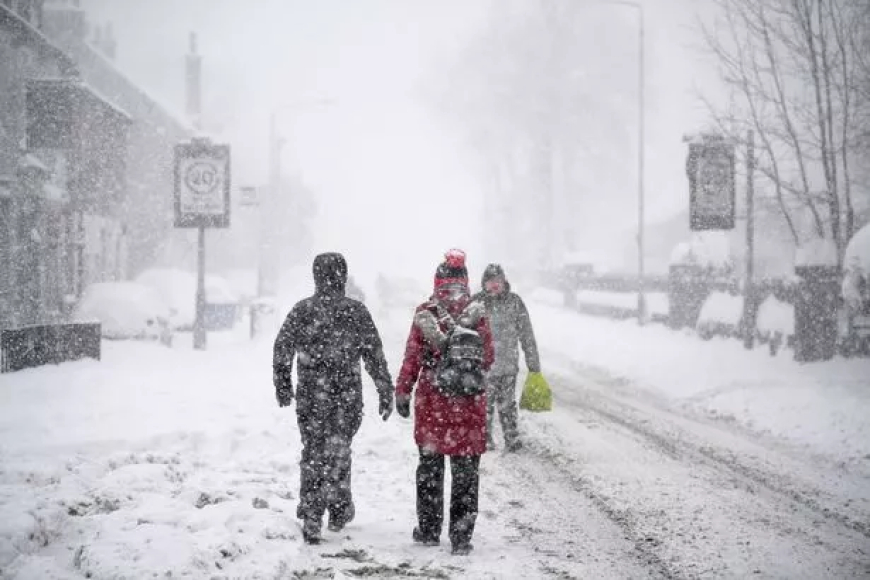Experts Warn: Pakistan Braces for One of Its Coldest Winters in Years
Pakistan is set to experience one of its coldest winters in recent history as La Niña returns, bringing below-normal temperatures and new climate challenges

Pakistan is preparing for what experts describe as one of the coldest winters in recent history, as the La Niña weather pattern strengthens across the Pacific Ocean triggering a ripple of temperature drops and climate disruptions nationwide.
According to the Intersector Coordination Group (ISCG) and UN-OCHA, the returning La Niña phase will likely bring below-normal temperatures and reduced rainfall in northern Pakistan, intensifying the strain on communities still recovering from last year’s devastating monsoon floods.
Pakistan is bracing for one of its coldest winters in decades, as the La Niña climate pattern returns to reshape global weather systems. Experts warn that temperatures are expected to fall well below seasonal averages, threatening crops, public health, and communities still recovering from catastrophic floods.
A report released by the Intersector Coordination Group (ISCG) in collaboration with UN-OCHA paints a concerning picture a long, cold winter compounded by weakened recovery infrastructure and limited energy resources.
La Niña Returns and It’s Stronger Than Expected
La Niña, part of the El Niño–Southern Oscillation (ENSO) cycle, occurs when Pacific Ocean surface temperatures drop below normal, disrupting global air currents and rainfall patterns.
This recurring phenomenon, scientists say, has returned for the fifth time in six years, signaling a worrying acceleration of global climate instability. The U.S. National Oceanic and Atmospheric Administration (NOAA) confirmed that La Niña conditions re-emerged in September 2025 and are expected to persist until February 2026.
“This La Niña may not be the strongest, but its timing and repetition are alarming,” said Dr. Irfan Nadeem, senior meteorologist at the Pakistan Meteorological Department (PMD). “Even a moderate La Niña can lead to extreme cold spells, reduced rainfall, and heightened smog especially when our ecosystem is already fragile.”
Regional Outlook: Cold North, Dry Skies
The ISCG report projects below-normal rainfall and lower temperatures across northern Pakistan, including Khyber Pakhtunkhwa, northern Punjab, Gilgit-Baltistan, and Azad Jammu & Kashmir (AJK).
Meanwhile, Sindh, southern Punjab, and Balochistan are likely to experience near-normal precipitation with occasional dry spells.
Climate experts attribute these shifts to a weak negative Indian Ocean Dipole (IOD) phase, which, alongside La Niña, will dictate the country’s upcoming winter behavior.
“Pakistan could see one of its longest cold stretches in recent years,” said Dr. Farah Sultan, a climate scientist based in Karachi. “This will have a direct impact on agriculture, public health, and power demand — especially in urban areas prone to smog and energy shortages.”
High-Risk Consequences for Agriculture and Health
The cold wave, coupled with ongoing recovery efforts from last year’s floods, could create a perfect storm of socio-economic challenges.
According to experts, the potential impacts include:
-
Delayed harvests and disrupted Kharif crop cycles due to freezing soil and reduced sunshine.
-
Increased cases of dengue, malaria, and respiratory infections due to stagnant floodwaters and poor air quality.
-
Glacial lake outburst floods (GLOFs) in high-altitude regions as temperatures fluctuate rapidly.
-
Declining river flows and irrigation shortages, affecting winter crops and hydropower generation.
-
Smog intensification across Punjab’s industrial corridor, worsening air pollution levels.
-
Livestock vulnerability in snow-covered areas where fodder becomes scarce.
“Pakistan’s most vulnerable communities are facing another test,” noted an ISCG spokesperson. “From farmers to flood survivors, this winter could push many back into crisis if timely action isn’t taken.”
A Cold Wake-Up Call for Climate Preparedness
While the La Niña event is expected to be short-lived and relatively mild globally, its localized impact on Pakistan could still be severe. Experts say this is due to weak adaptive systems, energy insecurity, and fragile agricultural resilience.
“The country’s infrastructure isn’t built for back-to-back climatic shocks,” explained Dr. Ayesha Malik, a climate policy researcher. “We’re witnessing how climate patterns are no longer predictable — every season carries its own set of emergencies.”
Pakistan has faced a series of climate-induced disasters in recent years — from record-breaking floods in 2022 to extreme heatwaves and now a potential cold crisis. Officials at the Ministry of Climate Change have urged provincial governments to begin early cold-weather preparations, including fuel supply management, vaccination drives, and public safety campaigns.
Global Trend, Local Consequences
The return of La Niña has already begun influencing global weather — from colder winters in Central Asia to wetter monsoons in Southeast Asia. For Pakistan, it is another reminder that climate change isn’t a distant threat it’s already here.
As winter edges closer, experts say the real challenge lies not in surviving the cold, but in managing the aftermath the pressure on crops, energy grids, and health systems that will follow.
For now, one thing is certain: Pakistan’s resilience will once again be tested by forces far beyond its borders.

 Israr Ahmed
Israr Ahmed